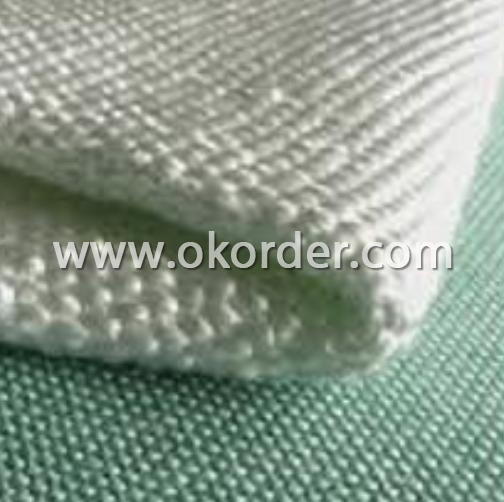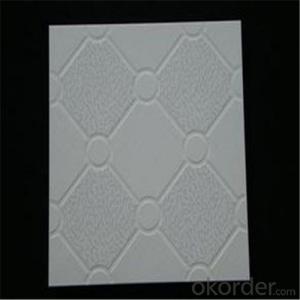Glass Fiber Textiles Textured Fiberglass Cloth
- Loading Port:
- China Main Port
- Payment Terms:
- TT or L/C
- Min Order Qty:
- 10 tons kg
- Supply Capability:
- 20*20FCL Per Month kg/month
OKorder Service Pledge
OKorder Financial Service
You Might Also Like
Specifications of Textured Fiberglass Cloth
1. Texturized fiberglass cloth 2. High temperature resistance 3. Fireproof 4. Thermal insulation
Texturized Fiberglass Cloth Description:
2. Insulating properties depend upon conductivity and radiation and these are influenced by the fabric construction.
3. It is the ideal substitue of the asbestos cloth.
4. It can resist 450-550C.
Texturized Fiberglass Cloth Application:
1. All types of thermal insulation and heat protection.
2. Welding blankets and fire curtains.
3. Expansion joints.
4. Basic cloth for coatings and laminations.


- Q: How are glass fiber textiles used in the electronics industry?
- The electronics industry extensively utilizes glass fiber textiles for various purposes. Insulation is one of the main applications of these textiles. Due to their exceptional resistance to heat and excellent electrical insulation properties, they are ideal for creating protective barriers around sensitive electronic components. This insulation helps prevent heat transfer and electrical short circuits, ensuring the safe operation of electronic devices. Another use of glass fiber textiles is in the manufacturing of printed circuit boards (PCBs). PCBs act as the backbone of electronic devices, facilitating the necessary connections between different components. Glass fiber textiles, specifically epoxy glass laminates, serve as the base material for PCBs. These textiles are impregnated with epoxy resin and layered with copper sheets, resulting in a strong and durable substrate for the circuitry. Furthermore, glass fiber textiles are employed to reinforce electronic components. By incorporating glass fibers into the manufacturing process of connectors, switches, and housings, the overall strength and structural integrity of these components are enhanced. This reinforcement allows for better resistance against mechanical stress, such as impacts or vibrations, ensuring the longevity and reliability of electronic devices. Additionally, glass fiber textiles have applications in electromagnetic shielding. They can be woven into conductive fabrics, which are used to create shielding enclosures or covers for electronic devices. This shielding prevents electromagnetic interference (EMI) and radio frequency interference (RFI) from affecting the performance of sensitive electronic circuits. By effectively blocking these interferences, glass fiber textiles contribute to maintaining the quality of signal transmission and reception in electronic devices. Overall, glass fiber textiles play a crucial role in the electronics industry by providing insulation, serving as PCB substrates, reinforcing electronic components, and contributing to electromagnetic shielding. Their thermal and electrical insulation properties, combined with their strength and durability, make them an essential material for ensuring the proper functioning and protection of electronic devices.
- Q: Can glass fiber textiles be used in soundproofing?
- Glass fiber textiles have the ability to be utilized in soundproofing. Recognized for their exceptional sound absorption qualities, glass fiber textiles are an ideal material for soundproofing endeavors. They effectively diminish the transmission of sound waves by absorbing and dispersing energy. Glass fiber textiles can be employed in a variety of soundproofing applications, such as wall panels, acoustic ceiling tiles, acoustic curtains, and insulation materials. By absorbing sound waves and preventing them from rebounding off solid surfaces, they effectively lower noise levels within a room, thus creating a more tranquil environment. Moreover, glass fiber textiles are lightweight, easy to install, and provide thermal insulation, making them a versatile option for soundproofing purposes.
- Q: How does the fiber length affect the properties of glass fiber textiles?
- The properties of glass fiber textiles are impacted by the length of their fibers. To begin with, longer fiber lengths generally result in stronger and more durable textiles. This is because the longer fibers interlock and bond within the fabric, increasing its tensile strength and making it more resistant to tearing or breaking when under stress. Additionally, longer fibers provide better flexibility and improved drapability to the fabric. They can be woven or knitted into complex patterns with greater ease, allowing the textile to be shaped and molded as required. This is especially important for applications where the fabric needs to conform to different shapes or be used in structural components. Moreover, longer fiber lengths enhance the thermal and electrical conductivity of glass fiber textiles. They provide a larger surface area for heat or electricity to transfer through the fabric. This is advantageous in applications where thermal insulation or electrical conductivity is necessary. However, it is important to consider the limitations of longer fiber lengths. They can make the textile stiffer and less comfortable to wear, reducing its suitability for clothing or soft furnishings. The longer fibers can also increase the weight of the fabric, making it less suitable for lightweight or high-performance applications. In conclusion, the choice of fiber length is crucial in determining the strength, durability, flexibility, thermal conductivity, and electrical conductivity of glass fiber textiles. It should be carefully considered based on the desired properties and specific requirements of the application.
- Q: Are glass fiber textiles suitable for filtration applications?
- Glass fiber textiles are a perfect choice for filtration purposes, as they possess exceptional filtration characteristics owing to their refined and compact composition. They possess the ability to apprehend and retain minuscule particles, thereby rendering them optimal for deployment in both air and liquid filtration systems. These textiles boast of an elevated filtration efficacy, ensuring the effective elimination of pollutants, dust, and other impurities from air or liquid flows. Moreover, their resistance to chemical deterioration and capacity to endure high temperatures make them well-suited for environments characterized by harsh conditions. Consequently, these textiles find extensive employment in critical sectors such as automotive, aerospace, pharmaceuticals, and water treatment, where efficient filtration plays an indispensable role.
- Q: How does glass fiber textile perform in terms of durability?
- Glass fiber textile is known for its exceptional durability. It has high tensile strength, meaning it can withstand heavy loads and resist tearing or breaking. Additionally, glass fiber textile is highly resistant to chemicals, moisture, and UV radiation, making it suitable for both indoor and outdoor applications. Its durability allows it to maintain its structural integrity and appearance over time, ensuring long-lasting performance in various environments.
- Q: How do glass fiber textiles contribute to fire resistance?
- Glass fiber textiles contribute to fire resistance by being inherently noncombustible. Unlike other textile materials such as cotton or polyester, glass fiber textiles do not catch fire or contribute to the spread of flames. They have a high melting point, which means they do not melt easily in extreme heat. Additionally, glass fibers are non-absorbent, so they do not hold or spread flammable liquids. These properties make glass fiber textiles an effective fire-resistant material, providing a barrier that can help prevent the ignition and spread of fires.
- Q: Are glass fiber textiles resistant to staining?
- Glass fiber textiles are typically resistant to staining. Their non-absorbent nature prevents them from easily soaking up liquids or substances that may cause staining. Furthermore, these textiles are frequently treated with a protective coating or finish that improves their ability to resist stains. As a result, they are widely preferred for applications like upholstery, curtains, and carpets where staining or discoloration is a concern. Nonetheless, it is crucial to acknowledge that although glass fiber textiles are generally resistant to staining, they are not entirely impervious. Certain powerful or heavily pigmented substances can still leave stains if not swiftly cleaned.
- Q: Can glass fiber textile be used in military applications?
- Glass fiber textiles have the ability to be utilized in military applications. These textiles are renowned for their exceptional strength and durability, which renders them highly suitable for a wide range of military uses. They can be employed for the production of protective clothing and equipment for soldiers, including bulletproof vests, helmets, and gloves. Military tents and shelters can also benefit from the use of glass fiber textiles due to their resistance to extreme weather conditions and fire. Furthermore, these textiles can be utilized to reinforce and enhance the structural integrity of military vehicles and aircraft. In summary, the remarkable properties of glass fiber textiles make them an invaluable material for military purposes.
- Q: Are glass fiber textiles fire-resistant?
- Yes, glass fiber textiles are fire-resistant.
- Q: How is glass fiber textile made?
- Glass fiber textile, also known as fiberglass textile, is made through a process called fiberglass manufacturing. The process begins with melting raw materials, primarily silica sand, at high temperatures to create molten glass. Other ingredients such as limestone, soda ash, and alumina may also be added to the mixture to modify the properties of the resulting glass fiber. Once the glass is in its molten state, it is then forced through tiny holes in a platinum alloy bushing, known as a spinneret. This process, called extrusion, allows the molten glass to form continuous filaments. These filaments are extremely thin, typically ranging from 9 to 13 micrometers in diameter. As the filaments emerge from the spinneret, they are rapidly cooled and solidified by passing through a series of water-cooled chambers. This solidification process is crucial in maintaining the integrity and strength of the glass fibers. After being solidified, the continuous glass filaments are collected onto spools, forming what is known as a glass fiber roving. This roving is then further processed to create different types of glass fiber products, including glass fiber textiles. To produce glass fiber textiles, the glass fiber roving is first pulled apart into individual filaments and then twisted together to form a yarn. The yarn can be treated with a sizing agent to improve its handling and processing characteristics. It can also be coated with a protective finish to enhance its performance and durability. The glass fiber yarn is then woven or knitted on specialized machinery to create various types of textiles, such as fabrics, tapes, or mats. The weaving or knitting process interlocks the glass fibers, creating a strong and flexible structure. Once the glass fiber textiles are produced, they can be used in a wide range of applications, including reinforcement in composites, thermal and acoustic insulation, filtration, electrical insulation, and construction materials. Overall, the production of glass fiber textiles involves melting raw materials into molten glass, extruding the glass through a spinneret to form continuous filaments, solidifying the filaments, collecting them into rovings, and further processing them into yarns. These yarns are then woven or knitted to create various glass fiber textiles with different properties and applications.
1. Manufacturer Overview
| Location | Beijing, China |
| Year Established | 1992 |
| Annual Output Value | Above US$ 3 Million |
| Main Markets | North America;Southeast Asia ;Western Europe ;Middle East |
| Company Certifications | ISO 9001:2008 |
2. Manufacturer Certificates
| a) Certification Name | |
| Range | |
| Reference | |
| Validity Period |
3. Manufacturer Capability
| a) Trade Capacity | |
| Nearest Port | Tianjing |
| Export Percentage | 60% - 70% |
| No.of Employees in Trade Department | 21-50 People |
| Language Spoken: | English; Chinese |
| b) Factory Information | |
| Factory Size: | Above 10,000 square meters |
| No. of Production Lines | Above 8 |
| Contract Manufacturing | |
| Product Price Range | High; Average |
Send your message to us
Glass Fiber Textiles Textured Fiberglass Cloth
- Loading Port:
- China Main Port
- Payment Terms:
- TT or L/C
- Min Order Qty:
- 10 tons kg
- Supply Capability:
- 20*20FCL Per Month kg/month
OKorder Service Pledge
OKorder Financial Service
Similar products
Hot products
Hot Searches
Related keywords




























